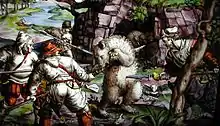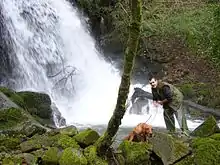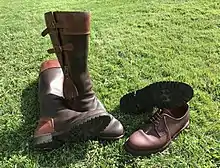Montería (hunt)
A montería (/mɒnˈtɛriːɑː/, Spanish: [mon.teˈɾi.a]), is an ancient type of driven hunt endemic to the Iberian Peninsula. It involves the tracking, chase and killing of big-game, typically red deer, wild boar, fallow deer and mouflon. A number of "rehalas" (packs of hounds) along with their respective "rehaleros" (unarmed beaters) will stir up an area of forest with the aim of forcing the game to move around and into the shooting posts, where hunters will be able to fire.[1][2]

The earliest records of monterías date back to the Late Middle Ages in the Crown of Castile, as can be seen with king Alfonso XI and his "Libro de la montería", published in the first half of the 14th century. Modern monterías in the Spanish sense are the result of around 300 years of evolution from the most primitive hunts that were common in the Middle Ages.
As of today, two types of monterías exist; namely the "montería española" or "a la española", practised throughout the southern half of Spain and Portugal and the "montería norteña", typical of the northern half of Spain. While the former is culturally unique, the latter is very similar to the rest of driven hunts occurring elsewhere in Europe. Historians refer to the period 1915-1931 in rural Spain as the "época de oro de la montería española" (golden age of the Spanish montería).[3][4]
The sport is controversial, particularly in Spain. Advocates of monterías view it as an intrinsic part of rural economies, as well as necessary for conservation and population controls, whereas opponents argue on the grounds of animal cruelty and lack of necessity.[5] In 2016, a study by Deloitte estimated that hunting in Spain generated about €6.5 billion of Spain's GDP, amounting to 0.3% of the country's economy and 187,000 jobs, monterías being a significant part of this.[6][7][8]
History
The first exhaustive works on hunting date back to the Late Middle Ages, when different royal houses and European nobles of Castile, Portugal, France, Germany etc. were commissioned the drafting of Hunting Treaties, the favourite activity of the ruling classes at that time, of which there are still a few in existence:
- “Libro de la montería” by Alfonso XI (14th century)

- "Tratado de la montería" by an unknown hunter from Sierra de Segura (15th century)
- "Le livre de chasse du roy Modus" (15th century) by Gaston III, Count of Foix (14th century)
- "Livro da Montaria" of the King John I of Portugal (14th century)
During the Middle Ages, different types of hunting were known in the Iberian Peninsula. Two very peculiar types were net hunting and vulture hunting, carried out mainly in the northwest of the Iberian Peninsula to hunt wolf.
However, the most common form of hunting throughout Spain and Portugal was that in which, prior to the actual hunt, the prey bedding place was sought by following the trail of the chosen animal with the help of a hound, to, once the location of the bed was known, place Alanos and sighthounds in strategic places of passage of said animal in order to catch it. To launch the animal towards the hunting posts, the bed was approached with hounds and chased by hunters on foot and on horseback to try and catch the game.
During the Middle Ages in Spain, this type of hunting was carried out mainly for hunting Cantabrian brown bears and wild boars, whereas in France it was more common with red deer.
From the Renaissance and especially since the widespread of firearms in the 16th and 17th centuries, medieval hunting evolved according to each territory and country, in modalities that today differ greatly from each other, such as hunting in the north of Spain (montería norteña or batida), the French "venerie" (on foot) and the "grande venerie" (on horseback), fox hunting in the United Kingdom or montería española or "a la española" in southern Spain and Portugal.
Montería norteña
As was done during the Late Middle Ages, in the north-northwest of Spain, wild boar is hunted in a modality called "hunt on leash". In this type of hunting, the bloodhounds and their beaters, the "monteros", play a leading role. Contrary to Spanish monterías, only wild boars are shot here, with the exception of foxes or occasionally 1 Iberian wolf per hunt.

In the early hours of the morning each beater goes out with his hound dog tied to a long leash called a "traílla" to look for the trail of wild boars. Once a trace of the previous night has been found, the beater, aided by the nose and ability of his hound, will follow the nocturnal footsteps of the animal, often for many kilometres until he finds the place where he is bedridden, resting during the day.
To corroborate that the wild boar is in a certain thicket, the beater and his hound, after entering the boar's trail in it, proceed to go around it to see if the boar has continued its path or remains resting. If it has left, the beater will continue following the trail with his hound on to another thicket where he will repeat the strategy. It is a hunt that requires great knowledge of the signals and customs of the different forest animals and a good physical condition, as well as well-trained dogs.
The beds of adult male wild boars are preferably chosen as the target of the hunt. Hunters are stationed with firearms surrounding the "mancha" thicket, whose extension can vary from a few hectares to several hundred. It is at that moment that a few hounds (usually between 2 and 10) are released on the trail of entry of the wild boar in the forest. The hounds mark the path made by the wild boar during the night with their voice, called "latido" (heartbeat), until they reach the place where the wild boar is resting, where the dogs bark at it continuously with courage but without attacking it directly. What is achieved through this strategy is that the wild boar breaks into a run while the hounds chase it "latiendo" (barking) until the boar is forced to pass through the "puesto" (post) where there is a hunter with his rifle, who tries to shoot him down. On many occasions the hounds have to chase the wild boar for a long time until it breaks at some point where a hunter is located.
Generally, the groups of people dedicated to this type of hunting, called "cuadrillas", are made up of up to 20 hunters, among which there is a variable number of beaters with their hounds, the number of dogs used in total ranging from 5 to 20.
This type of hunting is very selective, since the animal to hunt is chosen avoiding disturbing females with their offspring. Furthermore, practically no other animal is disturbed other than the one to be hunted (almost always boar in northern Spain) since it is an inexcusable mistake for dogs to chase any other animal than wild boar.
As can be seen, practically the only great difference that exists between this form of hunting and medieval hunting is that hunting dogs and sighthounds have been replaced by firearms.
Species that are currently shot in monterías norteñas include:
- Wild boar (always)
- Red fox (occasionally)
- Iberian wolf (occasionally and only north of the Douro river)
Cantabrian bears were hunted in monterías norteñas until 1967, when they were protected after almost becoming extinct.
Montería española
This type of hunt, much larger in extent, is carried out mainly in the centre and south of the Iberian peninsula, including the entirety of Portugal, and its existence is the result of an evolution that dates back to the 18th Century. Prior to the appearance of modern "Spanish monterías", hunting in Portugal and the southern half of Spain was very similar to the "montería norteña", the one that is still carried out in the northern half of Spain. This was apparent in the book "Tratado de la montería" published by the Duke of Almazán on a 15th century work by an Andalusian hunter from the Sierra de Segura. It is the most effective approach to harvesting big-game animals. More than 35,000 stags are taken each season in monterías.[9]
Wild boars and Iberian red deer are the most common species to be hunted in this type of montería, but also other species such as fallow deer, mouflon and formerly wolf and lynx.[10] In a forest or patch of several hundred hectares a series of so-called "armadas" or lines of positions with shooting posts, are arranged to surround and cover the mancha. Depending on their particular location in it, the armadas are called by various names ("cuerda" is the highest; "sopié" the lowest; "traviesa" is the one that crosses or is generally found in the middle of the area). From a certain end, or from more than one, the rehalas are released, and led by their respective beaters. They will beat the area in different directions with the ultimate aim of moving the game towards the hunting posts.[9]
Each rehala has between 10 and 20 dogs and is led by a "rehalero", "perrero" or "podenquero". The base of most of the rehalas dedicated to "southern-style hunting" consist of hound-type dogs (podenco andaluz), although those that are somewhat more specialised in wild boar use preferably mongrels of Spanish Mastiff, catch dogs, podenco or griffon.
A traditional rehala dedicated to hunting deer and wild boar, is normally made up of a majority of pure podencos, a minority of hounds and mastiff mongrels and a pure mastiff or catching dog collars (often alano or dogo).
This type of hunting consists of the use of a very high number of dogs that, led by their drivers, beat the ground to hunt in order to direct all kinds of animals towards the hunters (generally deer, wild boar, fallow deer and mouflon).

The dogs used in this type of hunting are generally not suitable for hunting in the traditional European manner.
It is not a selective modality, except for the instructions that can be given at the beginning of the hunt on the type of animals on which it is possible to shoot or not, and the selection made by the hunter at the time of shooting, knowing that in doing so he reveals his position more. For this reason, the most experienced hunters will avoid shooting on animals of little hunting value while waiting for what they consider worthwhile.
Species that are currently shot in monterías españolas include:
- Wild boar (usually)
- Stag (usually)
- Fallow deer (usually)
- Mouflon (usually)
- Red fox (occasionally)
- Roe deer (rarely)
Iberian wolves were shot in Spanish monterías until 1992, when the European Union Court declared it a "protected species south of the Douro river".[11] Iberian lynxes were also regularly hunted until they became almost extinct and were protected in 1970 in the entirety of the Iberian Peninsula.[12]
See also
Bibliography
External links
- A guide to a montería by the Real Club de Monteros (In Spanish)
- A short film of a montería in 1952 with General Franco (In Spanish)
- A short film of a montería in 2019 with Danish hunters
| Wikimedia Commons has media related to Monterías. |
References
- Florentino Pérez-Embid, Enciclopedia de la cultura española, Vol. 2, Editoria Nacional (Madrid, 1962), pp. 228–229
- Roberto Gazzari, Caza y fauna en Neuquén, Vol. 1, Siringa Libros (1978), p. 54
- Antonio Gil Olcina & Alfredo Morales Gil, Medio siglo de cambios agrarios en España, Instituto de Cultura "Juan Gil-Albert" (Diputación Provincial de Alicante, 1993), p. 204
- Víctor Rodríguez, "'El marqués de Viana y la caza', un libro sobre los años dorados de la montería" in Expansión, 7 February 2017
- ABC: La montería y la rehala como patrimonio cultural – 5 August 2020
- El Mundo: La caza defiende su actividad con cifras – 19 April 2018
- La Vanguardia: La caza genera 6.475 millones de euros anuales en España y emplea a casi 187.000 personas, según un estudio – 19 April 2018
- Expansión: La caza mueve 6.475 millones en España – 20 April 2018
- Anderson (1984). pp. 142-143
- Jesús Ángel Cecilia Gómez, "Especies cinegéticas españolas: descripción, modalidades de caza y trofeos" in Agricultura y Sociedad, Ministerio de Agricultura, No. 58 (Mar., 1991), p. 61
- Rafael Méndez, "El tribunal corrige a la Junta y prohíbe cazar lobos al sur del Duero" in El País, 21 November 2009
- Grupo Lince de la Sociedad Española para la Conservación y Estudio de los Mamíferos, Lince Ibérico: aspectos jurídicos para la conservación de la especie, SECEM, Imagraf (Málaga, 2010), pp. 31-33
